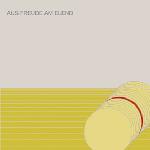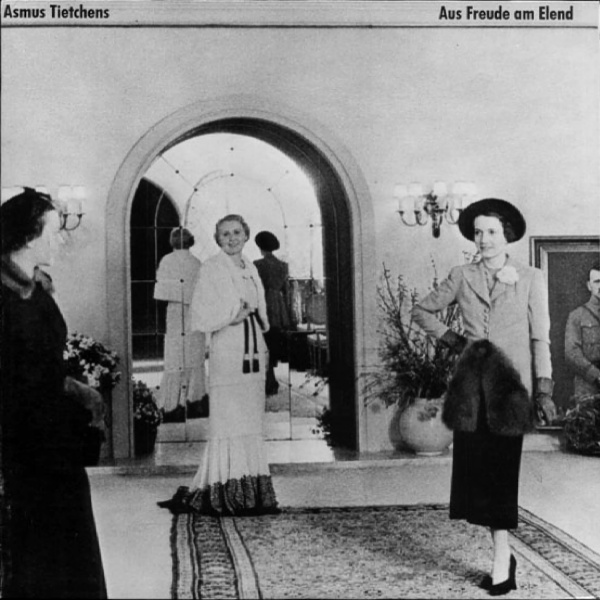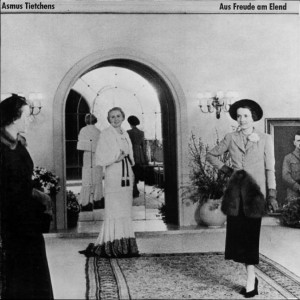A 19
AUS FREUDE AM ELEND
LP
Dom America • DOM LP 2 • USA 1988

CD
Die Stadt • DS 105 • Germany 2008
Part XI of the Rerelease series
Tracklist
Side A:
01 Den Stiftsherren 4’29“
02 Negus 5’25“
03 Rosenkranz 8’44“
Side B:
04 In memoriam P. F. 1’41“
05 Niederlage 3’20“
06 Paranoide Reflexe 5’01“
07 Nachbarschaft und Zeugung 3’17“
08 Weiter nicht 7’28”
Annotations
04 Dedicated to Peter Frankenfeld, a German comedian and TV host of 1950s to 1970s fame; the piece (unrecognisably) uses the title melody of his radio show Peters Bastelstunde.
Descriptions
Many pulses, with some more abstract sound constructs; in some cases (01 / 07 / 08), the original soundsource is still recognisable, so the turn into an entirely different mood makes these pieces particularly alien; sinister vaudeville of voices.
Source
Mainly human voices of diverse sources: religious chant, nocturnal recreation, old man singing and others.
Die Stadt label info for the reissue:
A S M U S T I E T C H E N S ‚Aus Freude am Elend‘ CD (DS105)
11th part in the ongoing re-release series of all early Tietchens albums between 1980-1991. AUS FREUDE AM ELEND is based on the human voice as a primary sound source and was originally released in edition of 500 copies on Dom America in 1988. The CD includes two previously unreleased tracks and comes in a jewel case with full color artwork and poster booklet also feat. the original front and back cover. First edition of 600 copies.
Asmus Tietchens AUS FREUDE AM ELEND (Dom America Dom US LP 02) 1988 Following my research of piano and water sounds (DS102, DS88) it didn’t come as a surprise that my next project was about the human voice as a sound source. The great masters of Plunderphonics already showed the way in the early 80’s, when they plundered the gigantic junk-shops packed full of already recorded material, which was stolen by them to use it for their own aesthetic targets. This album only consists of such stolen goods. Each track (with the exception of ‚In memoriam P.F.‘) was based on voices of people who I naturally didn’t ask their permission to use these recordings in the first place. So you can hear the voices of ecstatic religious people as well as other people making love. You’ll also hear someone singing to Annette and Peggy out of the trash bin of a publishing company. Even the screams of furious teachers came in handy while I made loops from them. Especially loops: Rarely before this album and only once after it (on Stupor Mundi) did I made use of the structural means of loops to such an extent. I was fascinated by the rhythmical and harmonic permanence, in the same way as many of my musical colleagues at the time. The aspect of the ‚Ritual‘ was a self-evident common formulation in difficult music during the 80s, so loops and tape voices, monotonous rhythms and LoFi became obvious means to shape the music. AUS FREUDE AM ELEND too was strongly spiced with these ingredients and therefore can be seen as a prototype album of this specific view of music during the time. This tendency was supported – even partly inspired – by a new generation of sound machines, which also made it possible for new aesthetic goals to appear at the horizon. The 90s were near at hand and sound art music would develop drastically in many ways in the years to follow. Samplers, digital editing, hard-disc recording and the first PC’s opened new doorways. Half of the material on AUS FREUDE AM ELEND was already created with these digital tools.
I never quite understood how the labels Dom America (run by Jon Carlson) and Dom here in Germany were connected. Did Carlson used to be a fan of Dom which was founded by Christoph Heemann and Achim Flaam. Did he simply liked the release politics of this label. And what became of Dom America ? Actually I don’t know. I guess it was one of the small enthusiastic independent labels which released a handful of titles and which disappeared after being active for a couple of years during the 80s. However AUS FREUDE AM ELEND had vanished shortly after its release. I only used ’stolen‘ voices twice again (‚Stupor Mundi‘, 1990 and ‚Das Fest ist zu Ende. Aus‘, 1993) after this album by the way.
Asmus Tietchens
Editorial notes:
All the tracks were copied from the original tapes which I found to be still in very good condition. The final track „Weiter nicht“ on Side-B of the LP ended with a lock groove. It’s presented here in its original length and therefore stops abruptly. The bonus track „Doch noch weiter“ was recorded almost one year after the release of the LP.
Total playing time: 50:04 min.
Track listing:
1. ‚Den Stiftsherren‘ 4’59
2. ‚Negus‘ 5’25
3. ‚Rosenkranz‘ 8’44
4. ‚In memorian P.F.‘ 1’41
5. ‚Niederlage‘ 3’20
6. ‚Paranoide Reflexe‘ 5’01
7. ‚Nachbarschaft und Zeugung‘ 3’17
8. ‚Weiter nicht‘ 7’28
Bonus:
9. ‚Doch noch weiter‘ 4’35
10.’Der verstümmelte Musikreferent 2′ (für Jüregn Drews-Goethe) 5’34


